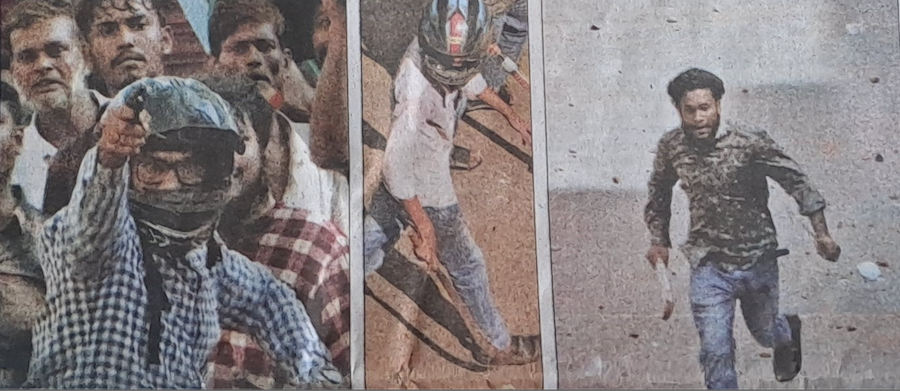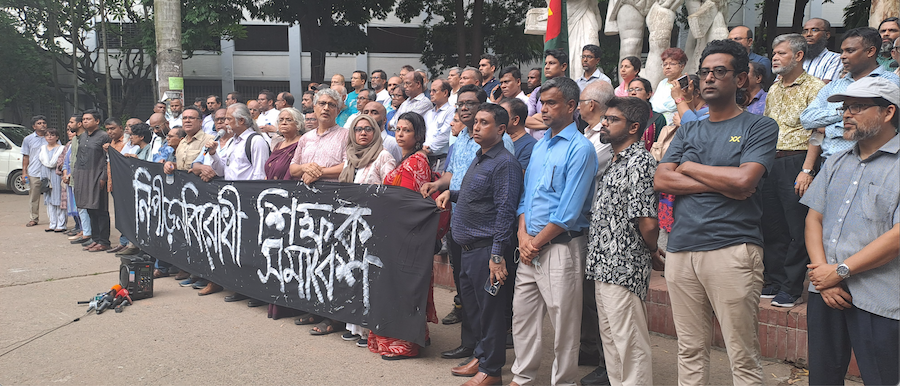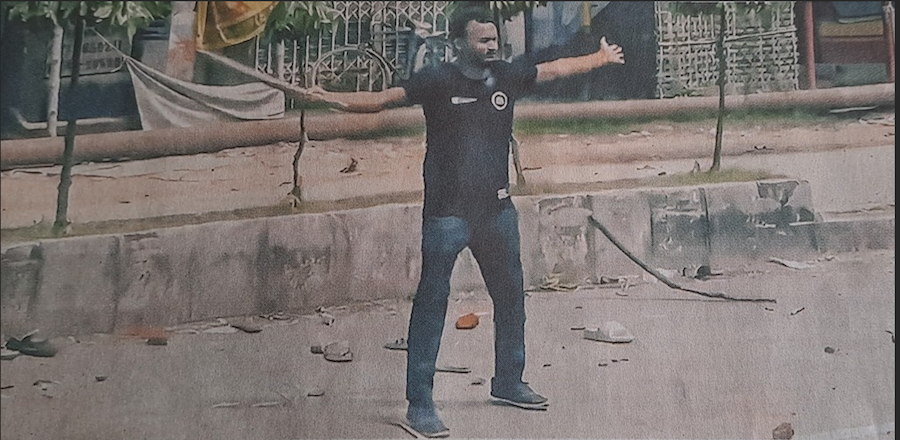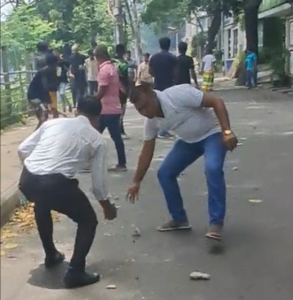Ten days in Bangladesh, a report on the uprising
An activist’s diary

In the first week of July, Bangladesh’s public universities were shut down by near-simultaneous walkouts by faculty and students. The faculty went on strike against a new pension reform proposal—which would impose a defined-contribution scheme involving salary deductions for the first time—and shut down Dhaka University (DU) and all the other public universities nationwide.
Separately, students walked out in protest against a High Court decision to reimpose a thirty percent quota in civil-service jobs for descendants of the muktijoddha (freedom fighters) of Bangladesh’s 1971 war of liberation. Until 2018, the law had provided affirmative action quotas for various oppressed groups and minorities, including women and people with disabilities. Alongside these smaller quotas was a hefty quota of thirty percent for the muktijoddha and their children.
In 2018, when the quota was extended to the grandchildren of muktijoddha, campuses erupted in protest and students demanded that the quota system be reformed and the muktijoddha quota be ended. This demand reflected a popular association of the muktijoddha quota with corruption and nepotism, and with the sense that retaining this quota fifty years after the liberation war was unnecessary. While the movement demanded a sensible reform of the quota system, the government responded in a manner that can only be described as petulant—they scrapped it entirely.
Earlier this month, when the High Court decreed that the government must re-implement the muktijoddha quota, protests erupted again. The government appealed the ruling, and the Supreme Court issued a temporary stay on the High Court ruling, but it was not enough to quell the protests.
Sunday, July 14
After days of protests, the prime minister for the ruling Awami League (AL), in a televised speech, snidely suggested that the students were rajakar (traitors)—pro-Pakistan collaborators during Bangladesh’s liberation war. The term, rajakar, is a well-worn dog whistle to the ruling party’s goons and a green light for the police and paramilitary forces. Following the lead of the prime minister, a leading member of party, Obaidul Kader, said in an interview that the party’s student wing and youth wing—Bangladesh Chatro League (BCL) and Jubo League—will give a “fitting reply” to the student protesters.1
Monday, July 15
As if on cue, BCL cadres came out in large numbers along with police and the aforementioned AL goons, wielding sticks, and attacking students at Dhaka University. Protests at other campuses were met with similar violence. In response, students defiantly took up the label of rajakar: If standing against the quotas makes us anti-national traitors, they said, so be it—we are all rajakar!
Tuesday, July 16
Police shot and killed Dhaka University student Abu Sayeed at point blank range. In a video that immediately went viral, Sayeed can be seen, arms spread wide, baring his chest at a phalanx of rifle-wielding police. Seconds later, he staggers around, apparently not aware that he’s been shot, until he falls to his knees, clutching his torso. He died soon after. Sayeed is one of hundreds of people, including many students, killed by Bangladeshi police and paramilitary forces in the last couple of days.
BCL attacks on the students continued. Many hundreds were reported injured in clashes. The video of Abu Sayeed’s shocking murder resonated with working class youth who can see themselves in him, and as it went viral, so did the protests.
The government shut down all universities and colleges indefinitely.

Wednesday, July 17
Two hundred faculty from different universities took part in a silent march to the Dhaka police station to demand the release of two students detained by the cops after they had been beaten up by BCL goons. Later, they marched to the vice chancellor’s residence to demand that student halls (dorms) not be shut down and that students be allowed to stay on campus if they choose to. There have been ongoing battles with supporters of the regime for control of the halls. For the students there is safety in numbers, and serious risks off campus where they have been targeted. After getting verbal assurances from the Vice Chancellor’s staff that students would be allowed to stay in the halls if they chose to, the group dispersed.
Nonetheless, hundreds of BCL cadres converged on the Dhaka University campus grounds soon after the faculty rally at the vice chancellor’s residence ended. While the vice chancellor had not called the cops onto the campus (the previous day’s rampage by the goons didn’t elicit any police response), Dhaka University was surrounded by all manner of police and paramilitary forces. Notwithstanding the presence of these forces in the area, many students were beaten, and some likely killed, by club- and gun-wielding BCL members late Wednesday afternoon and into the night.
In response, Gonotontro Mancho (Democracy Forum), a coalition of left and progressive groups, called on the government to step down.
That evening Prime Minister Sheikh Hasina, spoke on TV, briefly expressing concern over the deaths of the students before claiming that the violence was caused by outside agitators who had infiltrated the protests and that the police would take swift and stern action to deliver justice. Everyone knows this is a lie and a way to greenlight further repression.
As night descended, Dhaka University students issued a desperate call for the public to converge on the campus. Overnight the neighborhoods around university campuses awoke not only to sounds of protesting students but also to the sickening sound of teargas shells, sound grenades, and gunfire. With sporadic internet blackouts and social media censorship, it became difficult to sift fact from misinformation.
By now, students from various private universities—hitherto known for their quietist, apolitical campus culture—had joined the movement and started occupying roads and highways around the city. The students called for a total shutdown of the country Thursday.

Thursday, July 18
Reports came in of more dead. Throughout the day, into the night and the following day, masses of protesters clashed with police in running battles.
Broadband internet was cut late Thursday evening. If you don’t have cable TV, there’s little information on what’s going on. If you do, all you hear are reports of “skirmishes” with no context and bland praise of how the government is handling it.
A prominent left activist and dozens of his comrades were injured in a police baton charge but are okay. Friends call to check on us and urge us to stay indoors.
That night the government cut broadband internet access throughout the country.
Friday, July 19
The government imposed a curfew and called the army out onto the streets. Reports come in from across the city of street battles between police and rock-throwing crowds.
The protests are no longer against quotas alone but against the regime, its police forces, and its hired goons. Running battles between rock-throwing youth and police are taking place everywhere. Students have been joined by masses of working-class people. Throughout the night we hear the dull thump of teargas shells punctuated by the pop-pop of bullets and sudden bangs of sound grenades.
All day today, the battle for a bridge across a lake has raged, as large crowds of people wielding bricks and bats have tried to force the police out of Badda, a working class neighborhood that houses Brac University.) The protesters try to force the police out of their community and into the posh neighborhood on the other side. The crowds surge forward, are met by teargas shells, step back, surge again. Some shells are lobbed back towards the police, some into the lake.
On this side of the lake, dozens of working-class people, mostly men, are gathered in groups of ten or twelve, watching the drama unfold across the water. They are drivers, hawkers, street cleaners, security guards, and delivery boys. To the outsider (and there are many in this wealthy neighborhood) they appear to be mere onlookers, amused perhaps by what they are witnessing but otherwise untouched.
Suddenly, the surging crowd on that side of the lake takes about a third of the bridge. Police start backing up and into range of the onlookers on this side, who suddenly spring to life. Some start moving up the road towards the bridge while several others urge those at the back to join them. A crowd forms. Bricks are broken; projectiles start hurtling towards the police. Two rapid bangs and the gas shells land in the thick of the crowd. The people run back, regroup, and run forward again. People begin yelling to those on the other side of the lake to move forward—the idea is to trap the police forces in a pincer action. Get them! When a couple of guys try to raise a slogan, “Who are the police? India’s lackeys!” no one takes it up.
There’s no clear ideology here, just a burning, visceral rage against the state and its frontline defenders. Pick up a brick, a rock. Pick up whatever you can and fling it at them. Break up that bamboo fence and burn it in a pile so the smoke shields you from their guns. Those still lagging at the back are chided by two muscled youth: Join in! What is wrong with you?! Are you not men?! Anyone trying to capture the scene on video is discouraged; people are well-versed in the methods of state surveillance and repression. More tear gas. The crowd disperses. This goes on throughout the day and into the early evening, when suddenly a sustained barrage of shells and louder explosions is heard, and then silence.

Saturday, July 20
We woke up Saturday morning to an eerie stillness; the drone of a distant helicopter the only reminder of the ongoing crackdown.
Curfew had been imposed at midnight, and the army had been called out in a “supporting” role. There will be a relaxation of curfew for three hours in the afternoon.
Many pro-democracy activists have gone into hiding, including a prominent left activist who was beaten all over his body by police when he went to check on injured students at the hospital after they had all been beaten during a lathi charge while protesting.
It is clear that this is no longer about quotas. It is about a working class that has seen few dividends from the economic boom enjoyed by the wealthy. It is about a seething anger at the political establishment and the ruling elites. It is about a people fed up with joblessness, inflation, police brutality and impunity, corruption, nepotism, and along with it all, Prime Minister Sheikh Hasina’s authoritarian style of governance and haughty demeanor.
An activist closely connected to the student movement, also in hiding, told me of his fear that as many as 300 people might have been killed by police in the last few days in Dhaka alone. An anthropology student at DU, he says the movement has its contradictions—some in the movement want all quotas gone, while others want to retain quotas for oppressed groups; and the leadership is split between pro- and anti-government camps—but it will continue, because at its heart is the stark reality of youth unemployment.
People are breaking the curfew in a number of places; clashes with police re-emerge. The government announces that the curfew will continue and adds that violators will face a year in jail.
Sunday, July 21
The papers report that at least 136 are confirmed dead—many of them with bullet wounds—as of 10:00 pm last night. Many hundreds have been injured. This is the most violent such episode in independent Bangladesh’s history. Never before has the state been directly responsible for the deaths of so many of its citizens.
The state’s repression of the students has triggered a general unrest that has exposed simmering anger against the current regime. The scale of the state’s clampdown on travel and communication is indicative of the depths of the crisis. In Jatrabari, Mohammadpur, Mirpur and Azimpur—working-class areas in and around Dhaka–people reported war-like conditions: teargas and bullets being fired from helicopters and drones, random attacks on people in their homes, police raids that left people injured and even dead. In Narsingdi, a town northeast of Dhaka, nearly 900 prison inmates broke free of the jail and reportedly looted the armory as well, making off with nearly a hundred shotguns and rifles and some 8,000 rounds of ammunition. Police stations in this and other areas have come under attack; some have been abandoned and at least one has been burnt down.
There is anger against the authoritarian state, but there’s little place for progressives on the streets. Several progressive and left-wing solidarity events that had been planned for Friday were canceled for fear of being swamped and coopted by the Bangladesh Nationalist Party (BNP), Jamaat-e-Islami, and other right-wing organizations. BNP, the largest opposition party, is a conservative bourgeois party with some ties to right-wing Islamist groups. Given the absence of a viable left alternative, the BNP and Islamist groups like Jamaat will be vying for leadership in the streets and will likely succeed in broadening and deepening their base.

Meanwhile, rumors that a split has emerged in the Students Movement Against Discrimination, the coordinators of the student quota-reform movement. A faction of the leadership, led by Sarjis Alam, met with the government and presented a list of 8 demands including: reduce quotas in government jobs to under 5 percent; punish members of BCL for attacks on students; open an inquiry into the role of Obaidul Quader, a minister in the government, in instigating violence against the protestors; force the resignation of vice chancellors of various public universities for their failure to protect their students; and amnesty for students involved in protests.
Others on the coordinating committee have denied that Sarjis spoke on their behalf. Led by Abdul Kader, this faction has called on students to continue the agitation until all their nine demands are met, including: resignation of the home minister and Obaidul Quader; suspension of police officers in areas where protesters were killed; an unconditional apology from the prime minister taking responsibility for the protesters’ deaths; a ban on the BCL on campuses; and immediate reopening of campuses.
Nahid Islam, one of the coordinators, went missing after fifty to sixty police picked him up from a friend’s house late Friday night. The police denied having arrested him or any of the five other student leaders reported missing. He was found after being detained, tortured, interrogated, and left senseless in a remote part of the city.
Monday, July 22
Today, a much-awaited appellate court ruling. The government had appealed the High Court decision to reinstate the quotas abolished in 2018. The appeals court came up with a new quota formula: Seven percent reservations in all, with five percent for muktijoddha and 1 percent each for “third gender” people and for people with disabilities. They scrapped the quotas for women and marginalized communities entirely, and in keeping with the students’ demands, reduced reservations overall while appeasing the ruling party’s base with a five percent muktijoddha quota.
Some are saying that the death toll is upwards of a thousand. If true, this is unprecedented in independent Bangladesh’s history.

Tuesday, July 23
After three days of curfew, things are returning to normal in much of Dhaka. Reports from hospitals indicate that thousands have been injured. New Age reports that more than 800 leaders and activists of BNP and Jamaat-e-Islami have been arrested. All the violence is being blamed on them; the regime now reasserts control both of the streets and the narrative.
A significant portion of students—perhaps even a majority—are for the abolition of quotas entirely, demanding a so-called “meritocracy.” Others, the reformers, uphold the principle of quota-based affirmative action for oppressed groups, reject the muktijoddha quota, and call the meritocrats’ argument elitist. While quota reform seems to have been the dominant sentiment, students haven’t offered an alternative schema or system.
Two weeks into the protests, when a student leader spoke on TV in favor of quotas for women, she was berated by others in the movement, including some women who denounced her as anti-feminist! A couple of days later, she and another undergrad student at DU were beaten up by BCL goons in a targeted attack.
Fissures in the student leadership have been exacerbated, of course, by the crackdown, curfew, and internet blackout. They appear to be scattered and in hiding. One group is now calling for a regrouping of the movement to figure out next steps and has put forward a set of four demands geared towards reopening campuses and creating safe conditions for students to gather and discuss next steps.
Internet has been partially restored, but with no access to social media. Curfew will be lifted for a longer window today. The on-again, off-again drone of military helicopters continues throughout the day. As the dust settles, the question on everyone’s mind: Why did the government respond the way it did? It’s clear to everyone now that Sheikh Hasina’s rule is brittle and based on force, not consent. The protests are a reminder that this country has not seen credible elections for fifteen years, and people are fed up with one-party rule. Students have vowed to continue the agitation until all their demands are met.
The protests have also effectively nullified a trope that is the ruling party’s ideological mainstay—that they are the upholders of the ideals of 1971, the true legatees of the muktijoddha, defending the nation against rajakar, or traitors within. In the past, the regime effectively shut up and demobilized dissent by slandering them as rajakar. These protests have pulled the rug from under their feet as masses of students chanted, “We are rajakar!” in defiance of the regime’s slanders, and a video of a professor denouncing this knee-jerk characterization of dissent as anti-national has gone viral.
Nevertheless, as one longtime left activist said, the events of the past week do not bode well for the future. The sheer scale and scope of the regime’s violence is an index of their insecurity. The struggle for a functioning democracy with basic democratic rights will continue. The working class lacks organization. The Left is weak, fragmented, and for the most part in bed with Awami League. Who will replace the regime when it falls to the next round of unrest? Will it be the conservative BNP? Or parties to the right of them like Jamaat-e-Islami or Hefazat? A professor at a private university gloomily predicts that in the coming years either the army will take over or there will be civil war. Those who wish for a progressive alternative face an uphill battle. A beacon of hope is to be found in the students who have stood up bravely, suffered tremendously, and endured with dignity. They have no doubt learned lessons in this round of struggle that they have added to those learned in 2018.
Monday, July 29
Six student leaders, including Nahid Islam, now again in police custody, announced that they were calling an end to the movement. Campuses remain closed. The crackdown continues, with more than 10,000 arrests.
Categories
We want to hear what you think. Contact us at editors@tempestmag.org. And if you've enjoyed what you've read, please consider donating to support our work:
DonateArif Rashid View All
Arif Rashid lives and works in Bangladesh and is writing under a pseudonym.
